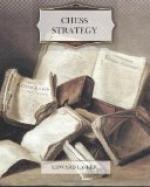Diagram 4 may serve as an example:
--------------------------------------- 8 | | | | | #R | | | #K | |---------------------------------------| 7 | #P | #P | #Q | #Kt| #R | | #P | | |---------------------------------------| 6 | | | #Kt| #B | #P | | | #P | |---------------------------------------| 5 | | | | | | | | | |---------------------------------------| 4 | | | | | | ^P | | | |---------------------------------------| 3 | | ^P | | ^Kt| | ^Kt| | | |---------------------------------------| 2 | ^P | ^B | | ^Q | ^R | | ^P | ^P | |---------------------------------------| 1 | | | | | ^R | | ^K | | --------------------------------------- A B C D E F G H
Diag. 4.
It is Black’s move, and we will suppose he wishes to play P-K4. A beginner will probably calculate thus: I push on my pawn, he takes with his pawn, my Knight takes, so does his, then my Bishop takes, and so on. This is quite wrong, and means waste of time and energy.
When the beginner considers a third or fourth move in such a combination, he will already have forgotten which pieces he intended to play in the first moves. The calculation is perfectly simple upon the following lines: I play P-K4, then my pawn is attacked by a pawn and two Knights, a Bishop and two Rooks, six times in all. It is supported by a Bishop, two Knights, two Rooks and a Queen, six times in all. Therefore I can play P-K4, provided the six units captured at K4 are not of greater value than the six white units which are recaptured. In the present instance both sides lose a pawn, two Knights, two Rooks, and a Bishop, and there is no material loss. This established, he can embark on the advance of the KP without any fear.
Therefore: in any combination which includes a number of exchanges on one square, all you have to do is to count the number of attacking and defending units, and to compare their relative values; the latter must never be forgotten. If Black were to play KtxP in the following position, because the pawn at K 5 is attacked three times, and only supported twice, it would be an obvious miscalculation, for the value of the defending pieces is smaller. [Footnote: It is difficult to compare the relative value of the different pieces, as so much depends on the peculiarities of each position, but, generally speaking, minor pieces, Bishop and Knight, are reckoned as equal; the Rook as equal to a minor piece and one or two pawns (to have a Rook against a minor piece, is to be the “exchange” ahead). The Queen is equal to two Rooks or three minor pieces.]




